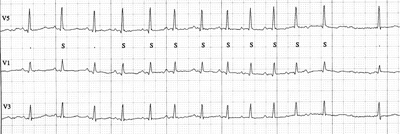
Atrial Tachycardia
Atrial tachycardia is an arrhythmia that arises from the atrial myocardium. The AV node passively conducts the impulses to the ventricles. There are two broad types of atrial tachycardia, distinguished by the underlying electrophysiologic mechanism. Intra-atrial reentry tachycardia occurs due to reentry and is most often sustained, regular, and with sudden onset and termination (generally initiated by an atrial premature beat or salvo of APBs). Automatic atrial tachycardia, on the other hand, is a disorder of impulse generation due to an automatic focus. This most often results in salvos of non-sustained atrial tachycardia exhibiting a “warm-up” or “cool-down” behavior. Both of these arrhythmias may be responsive to Class IA, IC, or III antiarrhythmic agents. AV nodal blocking agents will only slow the ventricular response to the atrial tachycardia but the arrhythmia will not terminate as a direct result. Some focal atrial tachycardias seem to be sensitive to calcium-channel blockers and can be managed effectively with oral verapamil. Those calcium-dependent atrial tachycardias are most likely due to triggered activity (delayed afterdepolarizations). Multifocal atrial tachycardia (MAT) is a distinct atrial tachycardia that exhibits three or more P-wave morphologies and rates of over 100 beats per minute. This is most commonly seen in patients with severe obstructive lung disease and also seems to be due to delayed afterdepolarizations. As such, it is most responsive to verapamil. Digoxin and Class I antiarrhythmic agents are not usually effective in the treatment of MAT. Treatment of MAT should also be aimed at optimizing pulmonary function. Atrial tachycardia is often curable with catheter ablation, particularly the focal variety.
In patients with drug-refractory atrial tachyarrhythmias such as atrial fibrillation with a rapid ventricular response, control of the ventricular rate may be effectively accomplished with catheter ablation of the AV node and implantation of a permanent pacemaker. This avoids the need for beta-blockers and calcium channel blockers (which may not be tolerated by many patients), eliminates complaints of palpitations from the irregular rhythm, and restores an appropriate heart rate response to exercise. At best, this is a palliative approach to atrial arrhythmias. Patients with atrial flutter and fibrillation still require lifelong warfarin therapy because normalizing the ventricular rate does not eliminate the stroke risk. In addition, most patients become pacemaker-dependent as a result of ablating the AV node, and this represents a potential risk in the event of pacemaker system/lead failure. Also, there is now ample evidence of the detrimental effects of permanent RV pacing on the efficiency of LV contraction and long-term cardiac function. Therefore, the use of the “ablate and pace” strategy has fallen out of favor, although this approach may be considered an alternative to medical therapy in older, less active patients with severe lung disease and/or an intolerance to calcium blockers and beta blockers.


